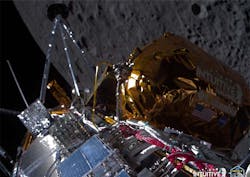Lonestar Data Makes it to the Moon on IM-1 Lunar Lander
Where is the outer boundary of the data center frontier? Today it is on the surface of the moon, in the form of a small data storage device from Lonestar Data Holdings.
Lonestar Data is a customer on a lunar lander from Intuitive Machines, which landed safely on the moon Thursday afternoon. At first, the lander was sending only a faint signal, but Intuitive Machines soon confirmed that the lander is “upright and starting to send data” and is working to capture the spacecraft’s first images from the moon’s surface.
The Intuitive Machines Odysseus lander became the first U.S. vehicle to land on the lunar surface since Apollo 17 in 1972. The IM-1 mission is the first under NASA’s Commercial Lunar Payload Services (CLPS) initiative, which seeks to create a lunar technology ecosystem to support future manned missions.
For Lonestar Data, IM-1 provides a proof-of-concept of its ability to save and restore data from beyond Earth’s orbit. The Florida startup plans to offer off-planet disaster recovery services for commercial customers, with plans to create “a series of increasingly sophisticated data centers on and around the Moon.”
A key test of their technology took place Monday, when the Intuitive Machines robotic lander was in transit to the moon. The Lonestar team transmitted a digital copy of the U.S. Declaration of Independence across space to the lander, which then sent back digital copies of the U.S. Constitution and Bill of Rights.
The company says the test is the first-ever digital document transmitted off-planet for disaster recovery storage services. Lonestar plans to send a larger data storage unit to the moon on another Intuitive Machines mission later this year, which will store data for customers including the State of Florida.
Data Storage to Support the Future Lunar Economy
Lonestar Data is the most ambitious of a group of startups hoping to offer edge computing in space. Several companies are integrating micro-data centers into their designs, offering computing power to process satellite imaging data or monitor distributed sensors for Internet of Things (IoT) applications.
With its mission to provide disaster recovery as a service (DRaaS) from the moon, Lonestar has taken an early lead in off-planet computing. The venture-backed startup company plans to provide secure digital services for enterprise and government customers, including direct services and partnerships with cloud platforms. Lonestar’s timeline has it launching commercial services in 2026.
"Lonestar is on a mission to save Earth's data, one byte at a time,” said Chris Stott, CEO of Lonestar Data Holdings, who said the mission brings them “one step closer to realizing our vision of establishing a secure, off-planet data storage infrastructure that can serve humanity for generations to come."
"This historic achievement is not just a technical milestone, but a testament to human ingenuity and the relentless pursuit of protecting the data that underpins our technological civilization,” Stott added.
It is not a mission without risk. While the IM-1 mission is experiencing some communications issues, it has fared far better than the Peregrine lander, a private lunar mission in January that experienced problems shortly after launch and later burned up in the earth’s atmosphere.
Lonestar and other CLPS participants are part of NASA’s effort to create a “lunar economy” to support its Artemis project, which plans to establish a long-term human presence on the moon, including a base camp where astronauts will live and work. Artemis II plans a manned lunar flyby sometime after September 2025, with the Artemis III crew scheduled to land near the South Pole of the moon (near the Odysseus landing site) after September 2026.
Lonestar is funded by Scout Ventures, Seldor Capital, 2 Future Holdings, IronGate Capital, The Veteran Fund, Atypical Ventures, Kittyhawk Ventures, and Backswing Ventures.
The Space Revolution Enables New Missions
Over the years, we’ve seen data centers in lots of new and strange places – caves, old chapels, floating platforms and underwater containers. The idea of placing data centers on the moon emerged as early as 2012, when a space conference heard a presentation for a lunar supercomputer.
Data transmission from space is hardly new, as satellites have been sending imagery back to earth since the earliest days of the space race. In 1990, the Voyager 1 space probe transmitted a photo of the Earth from a distance of 3.7 billion miles.
In recent years a revolution in space technology has created new business models, in which data and imagery are playing a leading role. The emergence of less expensive private space missions and “rideshare” services from providers like Intuitive Machines has opened space to a new breed of technology startups offering satellite broadband, Internet of Things networks, space lasers, and even colocation in Earth orbit.
As Lonestar advances its mission, several other startups are preparing edge computing from orbit. These include Sidus Space, which plans to launch a satellite with integrated edge AI software and hardware later this year. Then there’s Wallaroo.AI, which is working with the U.S. Space Force to develop AI models for edge computing from orbit. We’ve previously profiled Orbit’s Edge, a “space colo” company that has developed a compact rack design that will house servers inside a satellite.
But Lonestar has hit an extraordinary milestone with yesterday’s lunar landing.
"We believe that expanding the world's economy to encompass the Moon, Earth's largest satellite, is the next whitespace in the New Space Economy," says Brad Harrison Founder and Managing Partner of Lonestar backer Scout Ventures. "Data security and storage will be a necessary part of leading the new generation of lunar exploration."
About the Author




